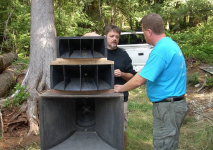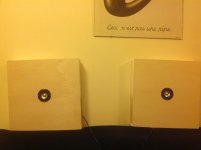I'm totally doing this. I still have a pair of Tang Band W3-881si (the buyout from parts express) left laying around. I've been to broke to take on a full sized project recently so this should tide me over for a while!
Still on my first one. 😱 It's going to be a while anyway because I need help cutting holes for the drivers into the plywood. I'm going to order the drivers and everything next week so it will still be a while before I've got one up and running. By the way, I'm thinking of the TB W3-1053SC instead of the vifa for this first go-around.Poke holes thru paper with sharp object and transfer points to connect. Don't you have master design on paper already or did you do direct draw onto back first time?
The w3-1053sc is smaller than vifa so channel depth is different, but will probably work fine. Vifa has larger xmax and a little more zing on top end. Either will work though.
I'm totally doing this. I still have a pair of Tang Band W3-881si (the buyout from parts express) left laying around. I've been to broke to take on a full sized project recently so this should tide me over for a while!
Kctess,
Glad to see you joining in, it's a blast and very easy. If you have the drivers already, it won't cost hardly anything. $6 for foam core and $2 for glue.
Good luck.
One of the things I'm looking at is the difference in Qts: the vifa is about .9, the TB is "only" around .6. According to MJK, high Qts will result in midbass bloat in a rearloaded horn, so the TB might have more balanced bass response in the cornu. (Probably a Qts of .3-.4 is ideal for this project.)The w3-1053sc is smaller than vifa so channel depth is different, but will probably work fine. Vifa has larger xmax and a little more zing on top end. Either will work though.
Good point about the Qts and mid bass, looking forward to hear how yours work out. For $10 more, the w3-315e has lower Qts at 0.52 even. I may try this one next.
George,
Your estimates of phase cancellation/boost assume the waves combine at the mouths of the horn? Doesn't this all change when the sound from each horn actually traverses the room and reflects off walls before combining with direct driver emission? The horns are side firing so really most of the output, I would expect, is indirect from walls, floors, ceilings. This was why I asked Pano to try the measurements farther back. But he said are we measuring the speaker or the room? True, but this speaker is critically dependent on room placement.
In case you may wonder, the spectral output of each horn is different, markedly because of the variations in length. I placed a mic at each mouth and fed pink noise into the driver. Just listening to the recorded sound replayed, you can tell one was mid bass and the other lower bass. It is very apparent to the ear even. Since these are hand built jobs, there are variations in the horn, so even the left and right horns are different slightly, same with up and down.
I am trying to get equipment to do a rough measurement of the spectrum. Pano suggested a great free software that I am trying to get working with my mic and computer. Not having a calibrated mic will only give a rough sense though.
Your estimates of phase cancellation/boost assume the waves combine at the mouths of the horn? Doesn't this all change when the sound from each horn actually traverses the room and reflects off walls before combining with direct driver emission? The horns are side firing so really most of the output, I would expect, is indirect from walls, floors, ceilings. This was why I asked Pano to try the measurements farther back. But he said are we measuring the speaker or the room? True, but this speaker is critically dependent on room placement.
In case you may wonder, the spectral output of each horn is different, markedly because of the variations in length. I placed a mic at each mouth and fed pink noise into the driver. Just listening to the recorded sound replayed, you can tell one was mid bass and the other lower bass. It is very apparent to the ear even. Since these are hand built jobs, there are variations in the horn, so even the left and right horns are different slightly, same with up and down.
I am trying to get equipment to do a rough measurement of the spectrum. Pano suggested a great free software that I am trying to get working with my mic and computer. Not having a calibrated mic will only give a rough sense though.
Last edited:
OK, here are 3 plots of impedance. I hope it's legible.
All were with the beginnings of the spirals medium stuffed with pillow fiber.
- Magenta trace = no stuffing in rear chamber
- Blue Trace = as much pillow stuffing as will fit
- Green Trace= 1 car polishing rag about 8"x11". A tight fit in the camber.
I'm new at this, help me out in interpreting it please. I think having more than the single peak at the driver's fs means that the two different horn tuning lengths do indeed have an effect on the back horn loading of the driver correct? The 70 something Hz freq matches what I calculated as the lowest freq based on the longest path. The 200 something Hz peak matches the shorter horn length from the split to the mouth.
Hi,
i made these drawings to ease scaling and printing.. first one is sebastian's original drawing and the other has more spiral shape. but i don't know if it has any advantages over the original, does it?
i have a pair of 3" full-ranges, may i use them for 70 cm panel or should i scale-down the layout to (3/4) 52.5 cm?
i also hope these pdfs helps to further builders..
xrk971, thanks for the bring us this project..
Endia,
Thanks for making the drawings - it will be useful for folks wishing to try a more rounded horn. I noticed that your version is smoother and more rounded - that will sound different but it is good to try different things. In fact, for my 14 inch (35.6 cm) cornu, I made it very round like yours and I like the sound it makes. FYI, Planet10 (and others) have made scalable pdf drawings too. I think it is on post 23 of the foam core thread. My guess is that the rounded horn will let more upper bass through, and mids and may be very good for people who listen to a lot of jazz, horns, woodwinds, and vocals. A 3 inch full range driver may be a little small for a full size 74 cm cornu. I did a 50 cm with a 3.5 inch driver, but a 3 inch driver could probably work up to ~60 cm size. It's really all new so who knows? If you try the 74 cm with a 3 inch driver and it doesn't work, you can always put in a 4 inch driver. Although when sizing the channel depth, you may want to pick a depth that in between the two drivers you plan on using. We are seeing depths ranging anywhere from 2.5 inch to 4.5 inch.
Good luck!
Bob just finished his build on the other thread! Check it out.
http://www.diyaudio.com/forums/full-range/223313-foam-core-board-speaker-enclosures-87.html

Congratulations Bob!
http://www.diyaudio.com/forums/full-range/223313-foam-core-board-speaker-enclosures-87.html

Congratulations Bob!
6L6 just finished his Cornu build. Congratulations 6L6! 
Ok, that makes the list of folks with successful cornus:
xrk971
Cal Weldon
Pano
Bcmbob
6L6
Am I missing anyone?

Ok, that makes the list of folks with successful cornus:
xrk971
Cal Weldon
Pano
Bcmbob
6L6
Am I missing anyone?
Uh, thanks Cal. 😉
I dunno if my Cornu has issues, or it's just the stuffing. Anyhow, I'd like to get the FR smoother.
To answer an earlier question:
When scaled to 20", the Planet10 PDF gives a mouth size of about 3.75". That's measured from parallel side to side on the section after the first corner. I.E. the first significant straight walls.
I dunno if my Cornu has issues, or it's just the stuffing. Anyhow, I'd like to get the FR smoother.
To answer an earlier question:
When scaled to 20", the Planet10 PDF gives a mouth size of about 3.75". That's measured from parallel side to side on the section after the first corner. I.E. the first significant straight walls.
That weekend is indelibly stamped in my memory bank.Uh, thanks Cal. 😉
August '08 - Michael (left) and I hugging speakers.
Attachments
Uh, thanks Cal. 😉
I dunno if my Cornu has issues, or it's just the stuffing. Anyhow, I'd like to get the FR smoother.
To answer an earlier question:
When scaled to 20", the Planet10 PDF gives a mouth size of about 3.75". That's measured from parallel side to side on the section after the first corner. I.E. the first significant straight walls.
Were you answering my question? I think my question was actually, what was the width of the throat section next to the driver?
A true Canadian B.S. session! Do you remember who won, the home team or the visitor?August '08 - Michael (left) and I hugging speakers.
Not sure what part that is. The opening into the horns?I think my question was actually, what was the width of the throat section next to the driver?
Yes, the gap of the horn inlet from the driver chamber. You and Cal look like you are in the jungles of Zimbabwe about to test out acoustic shock therapy for gorillas in the mist. 🙂
Yes, where the BS stands for Be Serious.A true Canadian B.S. session!
Pretty close, it's the wilds of Canada.You and Cal look like you are in the jungles of Zimbabwe
Actually that's a rocket powered speaker you see us attempting to hold down. Eventually we just had to let go. Serious thrust from that puppy.
Ok, that makes the list of folks with successful cornus:
xrk971
Cal Weldon
Pano
Bcmbob
6L6
Am I missing anyone?
I don't know if mine are successful, but they sounds quite good 😉
Attachments
- Home
- Loudspeakers
- Full Range
- Ever think of building a Cornu Spiral horn? Now you can!

